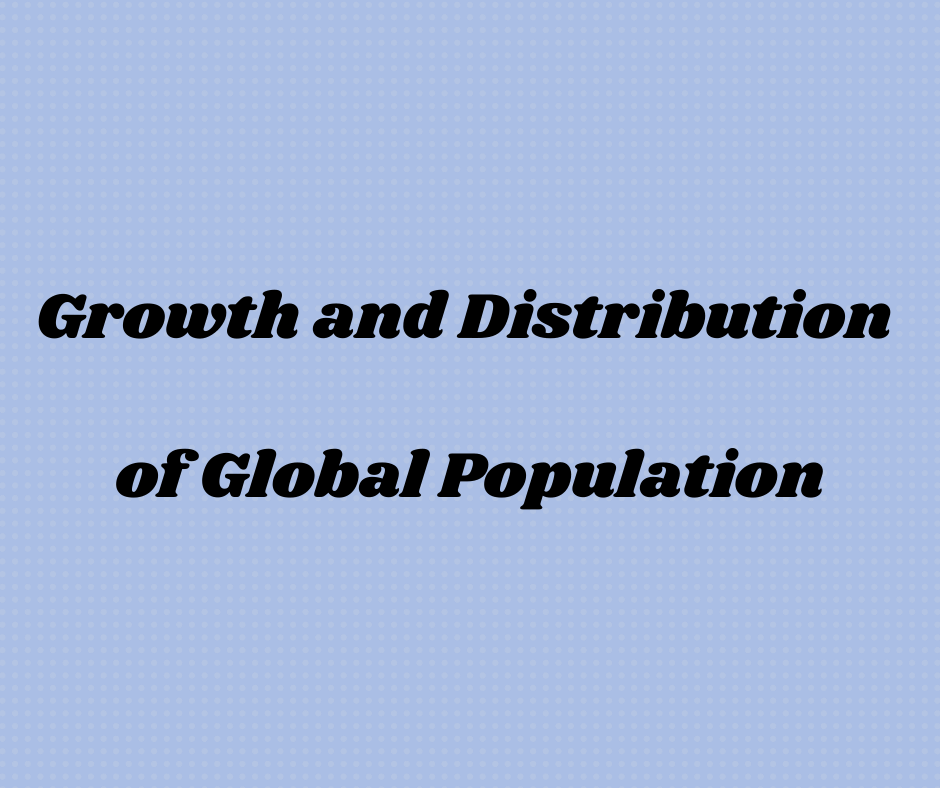Growth and Distribution of Global Population
In this article, we are going to study both the growth and distribution of world population. That is, both the temporal and spatial dimensions.
 Table of Contents
Table of Contents- Temporal differences in World Population Growth
- Differences in Distribution of World Population
Temporal differences in World Population Growth
The development of population profile in the global perspective is co-related to variable temporal phases.
So, we will have a look at various phases in the growth of world population, starting from the past and then moving on to the present and future.
Past Scenario of Population Growth
- High stationary stage of demographic development: Since the beginning of cultural history, that is 10,000 years B.C. to 1750 A.D., the growth trend of global population has been significantly slow.
- In the time frame of 1750-1950 A.D., there has been a slow growth in the global population, due to taming up of mortality rate by favorable development of carrying capacity.
- It is since 1950s that the growth of global population is specified to be most exponential, referred to as “J Curve”.
This explosive growth of global population when interpreted only in terms of increase in the human population, looks disproportionate. However, when this growth trend is seen in context of the growth in technological know-how and thus the carrying capacity, it is referred to as “S Curve”.
This curve is also related to Homeostatic plateau or Neo-Malthusian approach that takes into reference significant increase in human technological capacities to adjust the expendably growing population in the world. Since 1950, the 3 distinctive break-throughs that co-related to development of homeostatic plateau are green revolution, medical revolution and tele-communication revolution, in this chronological order.
Now, let’s have a look at the present scenario with an eye on the future.
Present and Future Scenario of Population Growth
In the present perspective, derived from 2010-11 UN population tables, global population is continuously maintaining Total Fertility Rate (TFR, at 3.3) over and above replacement levels. As per the population projections, the present population of approximately 7 billion is going to stabilize once it reaches approximately 11 billion by the year 2150. Maximum of this is likely to remain confined in African and Asian countries, as these countries are experiencing expanding stages of population.
Now, let’s have a look at the spatial differences in population growth.
Differences in Distribution of World Population
The pattern of population reveals highly uneven profile, which is projected in both total population and density distribution parameters.
Differences in Total Population
In terms of total population, only 10 countries of the world – China, India, USA, Indonesia, Brazil, Pakistan, Bangladesh, Russia, Nigeria and Japan account for 60% of the world population.
Lion’s share is confined to the 2 most populous countries - China (approximately 19% of global population) and India (approximately 18% of global population)
Differences in Population Density
In terms of density distribution, continental level analysis further proves disparity in distribution. As per 2011 population table, global population density (persons/km2) is 41.
- Asia (108), and Europe (101) are densely clustered continents, whereas
- Latin America (21), Africa (20), Anglo America (14) and Oceania are sparsely clustered continents.
With reference to the density distribution, the global population pattern can be categorized in 3 distinctive categories.
- Ecumene
- Non-Ecumene &
- Sporadic Ecumene
 Ecumene
EcumeneA term used by geographers to mean inhabited land.
Ecumene Category
Ecumene category represents dense clustered location, with population density of more than 100 person/km2.
In this category 4 well defined regions of world are included:
- East Asia – Both China and Japan are in the list of 10 most populous countries of the world. But there’s a fundamental distinction - China denotes the case of Extensive Ecumene, whereas Japan is an example of Intensive Ecumene.
- South Asia - India, Pakistan, and Bangladesh are in the list of 10 most populous countries of the world. They denote the case of Extensive Ecumene.
- West Europe - U.K., France and Germany. They denote the case of Intensive Ecumene.
- East-Central Anglo America – Canada and USA. They denote the case of Intensive Ecumene.
Non-Ecumene Category
Non-Ecumene Category includes extreme climatic and physiographic regions such as:
- Equatorial Rain Forests
- Tropical Deserts
- Polar Deserts
- High mountains
In all these 4 locations, there is very thin concentration of population (less than 10 person/km2).
In between these two extremes (Ecumene and Non-Ecumene), is the well-defined demarcation of Sporadic Ecumene category.
Sporadic Ecumene Category
It reveals the general pattern of distribution of global population. This category projects isolated facilitative factors to have generated dense population clusters, inspite of otherwise unfavourable geographical characteristics.
Regulated by fertile soil, Extensive Sporadic Ecumene locations include:
- Island of Indonesia
- Mekong delta of Vietnam
- Mesopotamian Plains of Iraq
- Nile Valley of Egypt
- Turanian lowlands of central Asia
Sporadic Ecumene regulated by availability of mineral or energy resources largely generates Intensive Ecumene, such as:
- Persion Gulf shore line (crude oil)
- Western Australia — Perth and Kalgoorlie (Iron & Gold)
- Sweden — Kerina and Gallivare (Iron ore)
- Siberia — Magadan (Coal)
- Alaska — Fairbanks, Fort Yukon (Placer gold)
Regulated by favourable climate, Sporadic Ecumene largely includes Intensive characteristics in the tall mountains, such as:
- Addis Ababa, Kampala, and Nairobi in Eastern Africa
- Sana’a in Asia (Yemen)
- La Paz in Bolivia (Additional benefit of highest attitude navigable Lake Titicaca)
Regulated by marine Network, commercially sound examples of Intensive Sporadic Ecumene include:
- Singapore
- Suez
- Honolulu
- Colon
- Havana
- Panama City
- Port Saeed
Beyond these 3 categories, the pattern of global population is generalised as Moderately Clustered.
